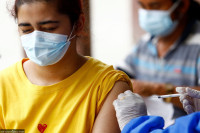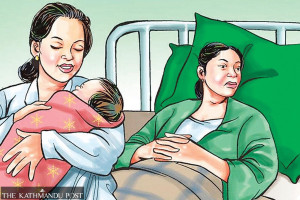Health
Nepal's Covid-19 infections cross 100,000 mark, as active cases soar and death toll hits 600
With government authorities failing to take any concrete measures to contain the virus, the country is headed for more difficult times, public health experts say.
Arjun Poudel
Nepal’s coronavirus cases crossed the 100,000 mark on Friday, with 600 total deaths, a situation public health experts had long warned about, while the government appears clueless about its next step to contain the spread.
Doctors say even more difficult days are ahead as the authorities have given up the fight against the pandemic.
“New cases have been doubling every two weeks or sooner. In the coming days, cases will start to double within a week, given the exponential rise in cases we are witnessing,” Dr Prabhat Adhikari, an infectious disease and critical care expert, told the Post.
“When the cases increase, the number of patients in need of intensive care unit beds and ventilators will also rise. The situation looks bleak.”
As of Friday, the total number of Covid-19 cases stood at 100,676. The Health Ministry said that the country recorded 2,059 new cases and 10 deaths in the last 24 hours. On Thursday, the ministry said 4,364 new infections were reported, the highest single-day spike. Twelve deaths were reported on that day.
The decline in new infections could also be due to the fewer tests conducted in the last 24 hours, experts say. Compared to the 18,473 polymerase chain reaction tests conducted on Thursday, only 13,279 were conducted on Friday.
With the country already running out of intensive care beds and ventilators, the authorities are left with no answers as to how they are going to deal with the pandemic whose full effects have now taken hold.
Dr Jageshwor Gautam, spokesperson for the Health Ministry, has already become an object of ridicule for the kind of “advice” he is offering to the general public.
On Thursday, Gautam said that the trend among people reaching the hospital even for cough and fever conditions was on the rise and that they should visit hospitals only if they “fall unconscious” or “are about to fall conscious”.
On Friday, instead of attempting to provide information on what the government is doing to deal with the worsening situation, Gautam “urged” people not to buy new clothes and celebrate Dashain at home and seek blessings from the elderly people via telephone and internet.
He also warned that people with the virus would be jailed if they fail to follow the 14-day home isolation protocol.
“As per the Infectious Disease Act-2020 (1964), authorities could put those violating the protocol in jail for six months,” said Gautam. “We have made recommendations to the Ministry of Home Affairs and the Nepal Police that the infected people be prevented from moving freely if they have not completed their 14 days of home isolation and that action be taken against them as per the law.”
Public health experts say while the general public must show some responsibility—wearing masks properly, using sanitisers and avoiding crowded places, ensuring people's safety is the government’s prime duty and that it cannot shirk it.
The Oli administration’s handling of the pandemic has been poor from the very beginning—from January when Nepal reported its first case. When it decided to enforce a lockdown starting March 24, when just two Covid-19 cases were reported, there were expectations that it would work to improve health care facilities, set up quarantine and isolation facilities and increase the number of beds and ventilators.
During the lockdown period, senior officials, including the prime minister and his ministers, however, continued to peddle mistruths, at times even making unsubstantiated claims that coronavirus won’t affect the country.
The Oli administration by and large was in a slumber during the lockdown period, experts say. When it lifted the virus restrictions on July 21, the number of Covid-19 cases had already crossed the 17,000 mark.
Since then, there has been no let-up, according to experts.
“The authorities enforced the lockdown too early without any scientific basis and when they lifted it, they did not give much thought about the possible threat,” said Adhikari. “The pressure in hospitals is too high now.”
According to government data, on Friday, there were 318 people in intensive care units and 75 on ventilator support. Among them, 196 were listed as critically ill and 57 were on ventilator support at various hospitals of Bagmati Province—a majority of them in Kathmandu Valley.
The Health Ministry claims that there are 2,600 intensive care unit beds and 900 ventilators across the country, but reports suggest Covid-19 patients are struggling to get beds and ventilators.
“We have tried almost all hospitals in Kathmandu Valley for an intensive care bed for a 33-year-old male Covid-19 patient, whose oxygen saturation has dropped to 84-85 percent,” a health worker working for Danphe Care, a private medical service that monitors the health of Covid-19 patients during home isolation, told the Post. “Such a drop in oxygen saturation puts Covid-19 patients at risk.”
Dr Baburam Marasini, former director at the Epidemiology and Disease Control Division, said the government made a series of mistakes to bring the country to such a situation.
“By asking people not to wear new clothes and not seek blessings and tika from the elderly won’t help control the spread,” said Marasini. “Concrete steps were needed to contain the virus spread and such measures are needed now also. I wonder why the officials responsible have not been sacked yet. They have made a spectacular bungling.”
Doctors say Nepal has yet to see the second wave of infections. But it’s not too far away, according to them, as it might take just about two months or so for the infection rate to reach its peak, especially in Kathmandu Valley.
According to the Health Ministry’s data, 37,720 people have tested positive in the Valley so far.
“Coming days will be more challenging,” said Dr Sher Bahadur Pun, chief of the Clinical Research Unit at Sukraraj Tropical and Infectious Disease Hospital, who has been critical of the government handling of the pandemic from the very beginning.
“If we do not work on a war footing to increase facilities, increase tests and ensure effective contact tracing, it will be very difficult to save lives.”




 13.12°C Kathmandu
13.12°C Kathmandu














